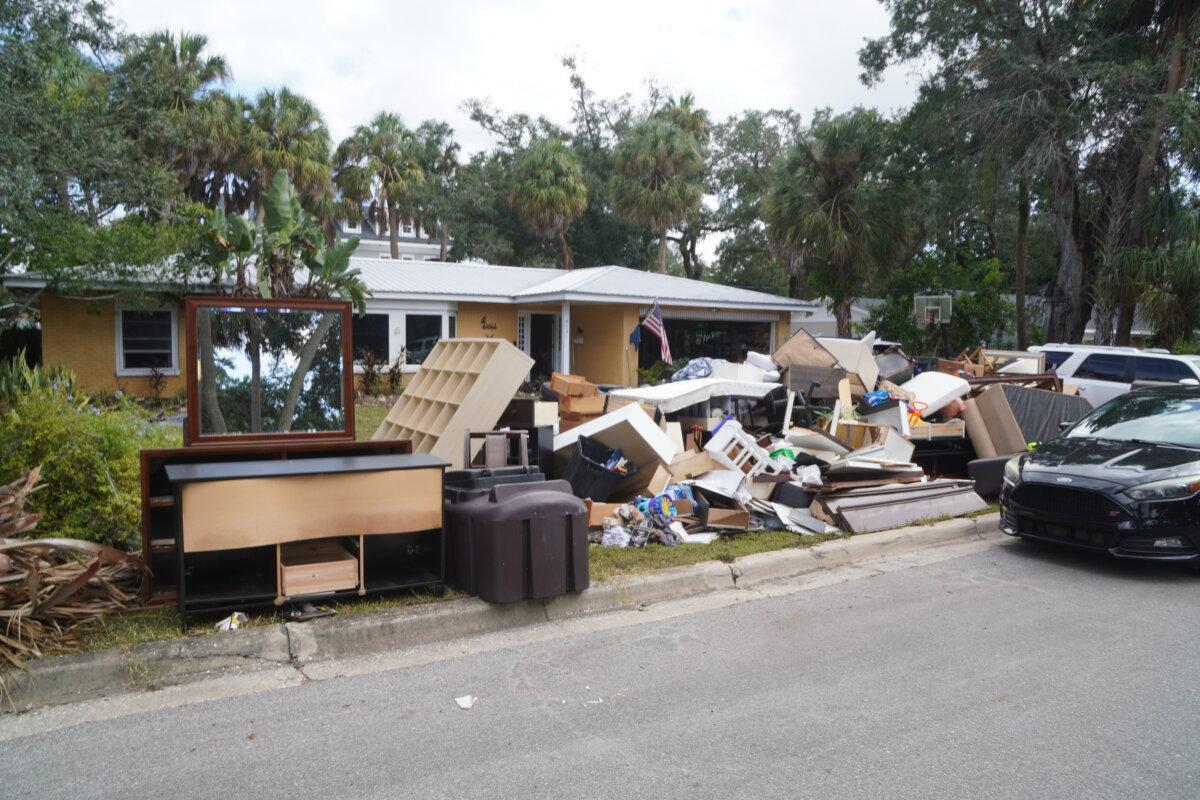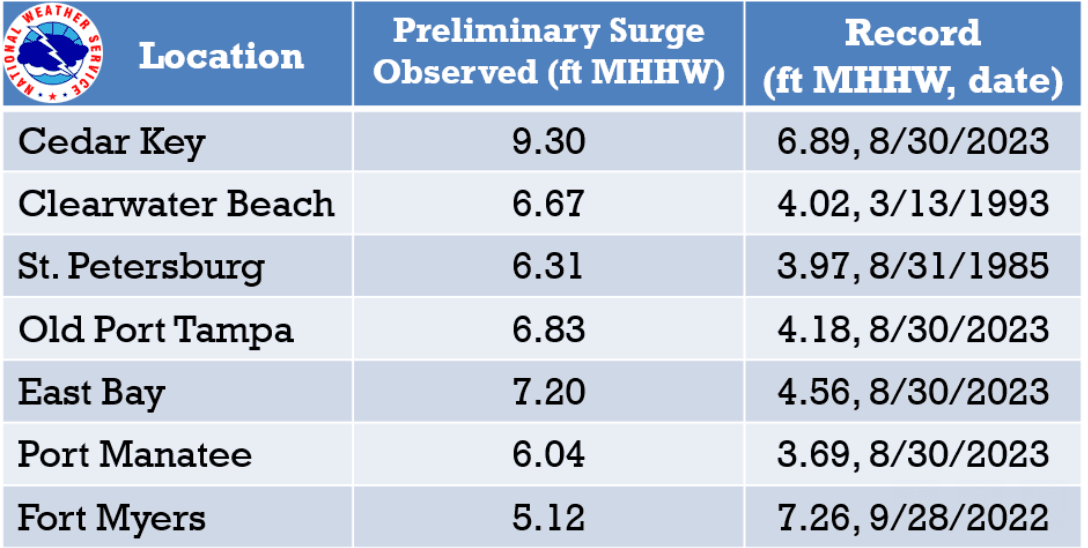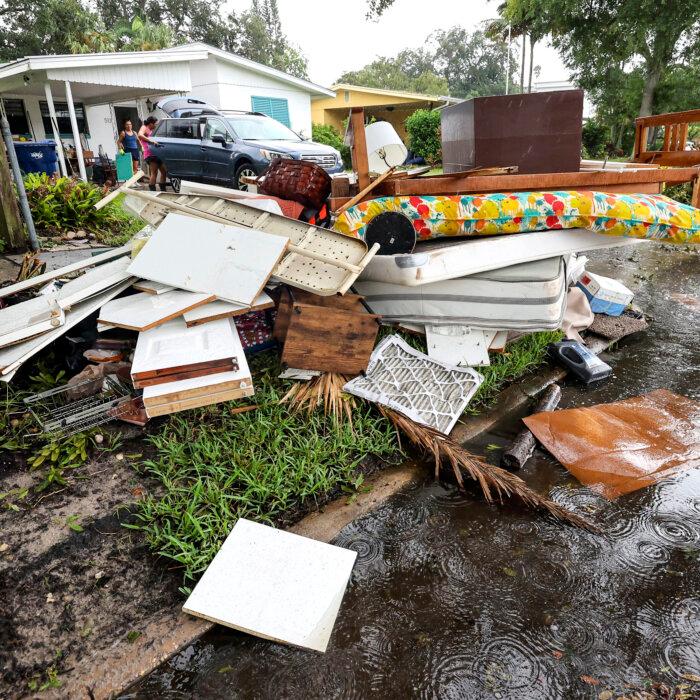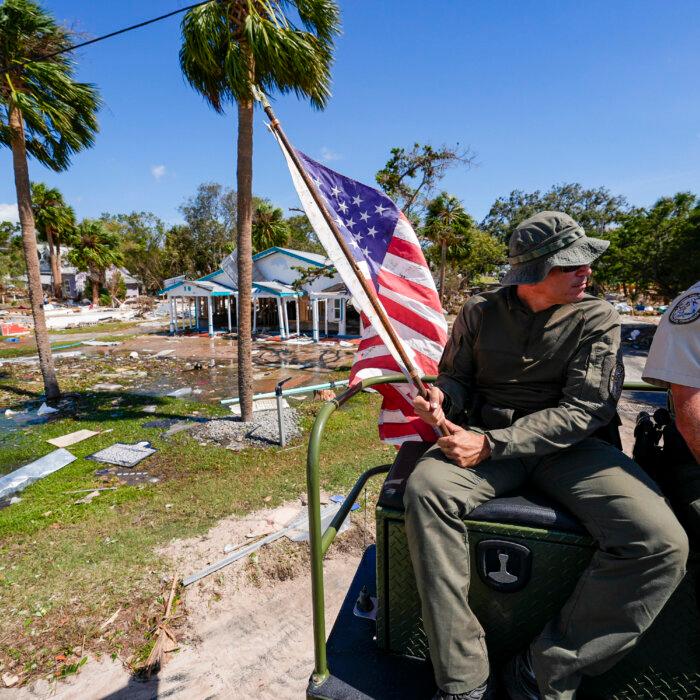TAMPA, Fla.—It was a storm surge of historic levels.
Hurricane Helene delivered record-setting amounts of seawater into Tampa Bay and onto the Gulf Coast beaches, according to the National Weather Service’s Tampa Bay Office.
The office told The Epoch Times that the preliminary storm surge measured as high as 7.2 feet in East Bay, located east of Ybor City; 6.83 feet in Old Port Tampa, located in South Tampa just north of MacDill Air Force Base; 6.31 feet in St. Petersburg; and 6.04 feet in Port Manatee.
Clearwater Beach registered 6.67 feet.
The influx of water, which began before sunset on Sept. 26 and reached its peak after 1 a.m. on Sept. 27, resulted in catastrophic and unprecedented flooding and multiple apparent drownings.
The barrier islands did not reopen to residents and business owners until 4 p.m. on Sept. 28. However, several roads, including portions of Gulf Boulevard, remain closed.
Across the bay in Hillsborough County, Sheriff Chad Chronister and his deputies have undertaken hundreds of rescue missions in the aftermath of the storm.
Community Relief
That sentiment was broadly shared, especially in the neighborhoods of South Tampa, where members of the First Presbyterian Church—known locally as “First Pres”—assembled on Sept. 29 to help their friends in need.The usual 2 p.m. service was moved to 9 a.m., and co-pastors Revs. Fitz and Kathy Conner put up a list of names, addresses, and needs of families who had been affected, and asked for volunteers. Nearly everyone in the congregation raised their hands and divided themselves up to serve the more than 20 families who had called for help.
Fitz set off as well to visit as many homes on the list as he could, while Kathy stayed behind to keep the church child care center open so the parents could go out and help.

Included on that list were Aubree and Austin Figler, Dan and Lissette Penrod, and Laura and Scott Gattis.
All three couples told The Epoch Times they obeyed the evacuation orders but came back to devastating flood damage they did not expect. In fact, all three said it was the first time their homes ever flooded during a hurricane.
“I thought, at worst, I'd get maybe some water inside, maybe a foot,” Austin Figler, 35, told The Epoch Times. ”I thought that was going to be the worst of it, so we didn’t put anything up.”
After sandbagging every entry point of his 1950s single-story Florida rancher, Figler evacuated with his wife and three children.
However, Helene’s storm surge surrounded his home with four feet of water and filled the inside with three feet.
Dan Penrod told The Epoch Times that his neighbors had lived next door for 60 years and their home had never flooded before. However, his home had around three feet of water outside and more than two feet of water inside.
“We expected something more in line with Idalia,” he said. “We had water about halfway up our driveway.”
Laura Gattis told The Epoch Times that her family had 12 inches of water in their home, but it got into their air ducts. So the ductwork will have to be replaced, along with all of the floors, furniture, and appliances.
She said that her family evacuated “last-minute” after a friend called and told them to expect about 12 inches of water in their house. They lifted what they could off the floor and put waterproof tape on all of the entrances, but the water still got in.
“I didn’t know 12 inches could do so much [damage],” she said.
Friends and fellow church members visited each affected home to help sort through what possessions could be saved and what needed to be thrown away, carry soiled furniture to the curb, rip up ruined floor boards and carpeting, and provide lunch.

As the curbside piles of saturated rubble, possessions, and memories grew throughout the morning, the scenes were still filled with laughter and smiles.
“We’re wrapped in, like, so much love and community and our church,” Gattis said. “And it’s the thing that’s making us emotional is all the love, not really the loss. So we’re all doing okay. We’re being taken care of very well by friends.”
Penrod said: “It’s been incredible to see the amount of outpouring of support, willingness to help—just people reaching out.
“I think the silver lining I see in all this is that as divided as things have been, something like this brings the humanity out in everybody.”
All three families told The Epoch Times that they were expecting a storm surge level similar to Hurricane Idalia in 2023, but what arrived was worse, and on an unprecedented level.

Worse Than Idalia
Jennifer Hubbard, warning coordination meteorologist at the National Weather Service in Tampa Bay, said that while the data at the different stations vary, she could confidently say that this was the highest storm surge recorded in the Tampa Bay area in at least 50 years.“The 1921 hurricane likely did have higher surges in Tampa Bay than what we’re seeing with this,” she said. “But otherwise, this did beat any records that were within that more like 50-year timeframe.”
But she said that a major 1921 hurricane is not included in the official records.
“Records do go back as far as 1947 at the St. [Petersburg] site,” Hubbard said. “But it is kind of a mixed bag of how far back records go at the stations that have water level data across the Tampa Bay area.”
While the St. Petersburg station dates back to 1947, the Clearwater Beach station did not open until 1973, and the Old Port Tampa station did not open until 1996.
Hurricane Idalia previously held four of these stations’ records, including 4.18 feet to Old Port Tampa, 4.56 feet to East Bay, and 3.69 feet to Port Manatee.
St. Petersburg beat its record of 3.97 feet set during Hurricane Elena on Aug. 31, 1985.
Clearwater Beach’s surge record was also broken, topping the 4.02 feet of storm surge delivered in March 1993 by the “no name storm,” also called “the storm of the century.”
The Cedar Key station, which dates back to 1914, measured 9.3 feet of surge, beating Idalia’s record of 6.89 feet.
Fort Myers, on the other hand, recorded 5.12 feet of storm surge, which didn’t surpass the record of 7.12 feet set during Hurricane Ian in September 2022.

The National Weather Service will be conducting its own storm surge surveys in the coming week.
It is a sobering feeling seeing the devastation that occurred on our coastline, Hubbard said. Even though you know it’s going to happen, it’s still shocking to see the actual aftermath.
In the wake of Helene, families across Florida—and the southeast U.S.—have a decision to make: stay or leave. The Epoch Times asked all three families if they planned to stay and rebuild their homes.
Figler had not made up his mind yet.
“We have three options,” he said. “Either we renovate and live here, renovate and sell, or take the money and run. So I just need to have conversations with my financial adviser, and the market’s going to be saturated for tear-downs. So can’t imagine we'd get very much for it if we went that route.”
Penrod was not sure either.
“A lot of decisions to make,” he said. “It’s one day at a time. We wake up, we make a plan, and then take what the day gives us.”
However, Gattis said her family was already planning on staying, rehabilitating, and moving back into their home.
“We love our neighborhood,” she said. “We love our neighbors. We are just so tight with each other and feel like that’s what makes a home—the people you’re surrounded by.
“I just can’t imagine being surrounded by any other people.”







